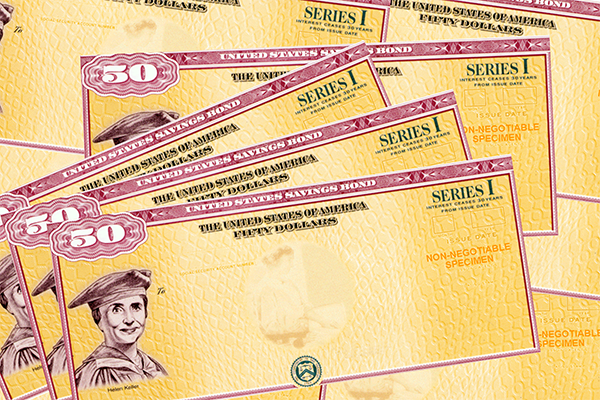The Financial Planner
I Bonds: Surprisingly High Interest Rates

Most of us rarely think of buying I Series Bonds from the U.S. Treasury. However, the current interest rate for these bonds has been getting some attention in the news at a whopping 7.12%!
Read an article written by Jeff Levine linked below explaining what you need to know if you are looking for a better return on cash that you will not need for the next year or more.[1] If inflation expectations hold true into May when the rate is reset, these bonds should still provide a better overall return than most bank savings accounts.
From the Levine Article
I Bonds are offered via the Treasury Department and are backed by the U.S. government. You can purchase them through the TreasuryDirect website, with limits of $10,000 annually per person. What makes I Bonds unique is their interest structure, which consists of a combined “Fixed Rate” and “Inflation Rate” that, together, make a “Composite Rate”—the actual rate of interest that an I Bond will earn over a six-month period.
While the current Fixed Rate for newly purchased I Bonds is 0%, the Inflation Rate for I bonds purchased before May 1, 2022, is an annualized 7.12%. This means that the Composite Rate is also an annualized 7.12% for the first six months that the I Bond is held—the highest rate of I Bonds since May 2000. After this time, a new Composite Rate will be determined by any changes to the Fixed and Inflation rates. While I Bonds have a 30-year maturity, they can be redeemed after being held for at least 12 months. Investors who redeem I Bonds between 12 months and five years after issue will forfeit the last three months of interest, but I Bonds held for more than five years can be redeemed at their current value.
The $10,000 annual limit on I Bond purchases restricts their benefit for those with larger portfolios. Still, there are several ways investors could increase the amount purchased at the current favorable Composite Rate. For example, because the annual limit is a calendar-year limit, individuals could buy $10,000 worth of I Bonds before January 1, 2022, and then an additional $10,000 between January 1 and April 30, 2022. For instance, a couple could purchase a combined $40,000 worth of I Bonds and receive the annualized 7.12% Composite Rate for the first six months the bond is held. In addition, I Bonds can also be purchased for children or by trusts and estates, which could further increase the amount purchased. Finally, paper I Bonds can be purchased using a tax refund up to a $5,000-per-return limit, which is in addition to the $10,000 annual limit on I Bonds purchased through the TreasuryDirect website.
How to Buy I Series Bonds
First you need to open an account on TreasuryDirect: https://www.treasurydirect.gov/
You will need to have your bank account number and routing number for the account where the money will be coming from to buy the bonds. You will also need your driver’s license number and expiration date. Treasury Direct will be sending you two emails, one with your unique account number and one that allows you to set up your password. Just follow the instructions, and it should only take a few minutes to set up.
Is it a Good Idea?
Well, the Treasury issued a record-breaking $1.312 billion of Series I bonds in November.[2] That means a lot of people are looking for inflation protection, higher yields, and the security of a bond backed by the U.S. Government.
It can be a good idea if you have excess cash that you won’t need to access for at least a year or more, and you like the idea of receiving higher interest and inflation protection on at least a portion of this cash. The previous composite rate on these bonds was 3.54%, still higher than at the bank. The variable rate of the bonds is based on the CPI (Consumer Price Index), so no one can predict how the returns on the bonds will change in the future. There is also a tax break—the interest on Series I Bonds is subject to federal income tax but not state or local taxes.
Despite the favorable interest rates, the drawbacks of setting up an account, making transfers, and a purchase cap amount of $10,000 per person per year may dissuade you. You will also need to keep track of your account number and password. You will have to decide what the right option is for you.
References
1. “The Secret is Out on 7.12% Inflation-Protected Bonds,” Brian Chappatta, Bloomberg Opinion, Markets, 12/7/2021; https://www.bloomberg.com/opinion/articles/2021-12-07/the-secret-is-out-on-7-12-inflation-protected-bonds
2. “Series I Savings Bonds: End-Of-Year Strategies to Take Advantage Of The Current High Interest Rate,” Jeff Levine, Nerd’s Eye View, Kitces; https://kitces.activehosted.com/index.php?action=social&chash=b4d168b48157c623fbd095b4a565b5bb.1187&s=f24aa7eafe7e5cff082cce0c4ebbeb0e
Suzanne Tudor
Suzanne has over 35 years of experience in financial services, retiring in 2024. She was a senior investment consultant and director of financial planning at Allodium Investment Consultants, located in Minneapolis, MN. Suzanne was passionate about helping families and business owners to strategically develop and carry out their financial, legacy and philanthropic plans. Since retiring, Suzanne has had extra time for activities she loves, such as spending time with her family and making DIY home improvements.
The information provided is for educational purposes only and is not intended to be, and should not be construed as, investment, legal or tax advice. Allodium makes no warranties with regard to the information or results obtained by its use and disclaim any liability arising out of your use of or reliance on the information. It should not be construed as an offer, solicitation or recommendation to make an investment. The information is subject to change and, although based upon information that Allodium considers reliable, is not guaranteed as to accuracy or completeness. Past performance is not a guarantee or a predictor of future results of either the indices or any particular investment.
